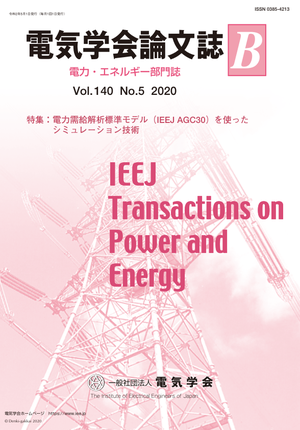Proposal of New Base Curve for IEC 60060-1 and Compensated Impulse Voltage Generator's Waveform Parameters
Proposal of New Base Curve for IEC 60060-1 and Compensated Impulse Voltage Generator's Waveform Parameters
カテゴリ: 論文誌(論文単位)
グループ名: 【B】電力・エネルギー部門
発行日: 2020/05/01
タイトル(英語): Proposal of New Base Curve for IEC 60060-1 and Compensated Impulse Voltage Generator's Waveform Parameters
著者名: Shuji Sato (Faculty of Science and Engineering, Hosei University), Seisuke Nishimura (Engineering Science, Yokohama National University), Hiroyuki Shimizu (Fundamental Engineering, Nippon Institute of Technology)
著者名(英語): Shuji Sato (Faculty of Science and Engineering, Hosei University), Seisuke Nishimura (Engineering Science, Yokohama National University), Hiroyuki Shimizu (Fundamental Engineering, Nippon Institute of Technology)
キーワード: impulse generator,compensation circuit,base curve,IEC 60060-1: 1989,IEC 60060-1: 2010
要約(英語): When a large capacitive load is connected to a lightning impulse generator, a value of T1 tends to become large and efficiency of the impulse generator deteriorates because a voltage drop across the main capacitor becomes non-negligible whilst a stored charge in the main capacitor flows out to the capacitive load at the wave front. The situations are often observed in power cable or UHV apparatus test. This problem can be solved by inserting an inductor series to the front (series) resistor. There is, however, a drawback with this solution: the inductor and capacitive load make oscillation circuit and the output waveform has a heavy oscillation around the peak. The so-called compensation circuit has been introduced to mitigate the superposing oscillation problem. The compensation circuit is effectively a hardware low-path filter and oscillation disappears. As a result, one can obtain a smooth output waveform. Authors started casting doubt on the waveform parameters obtained with IEC 60060-1: 2010 procedure. This is because the output waveform (i.e. the recorded curve) cannot be approximated by the base curve (the sum of two exponential functions) obligated in IEC 60060-1: 2010. In fact, there was an intolerable difference between T1 values evaluated by IEC 60060-1: 1989 and by IEC 60060-1: 2010 procedures. In the paper the followings are to be explained: 1) T1 value with IEC 60060-1: 2010 is erroneous, 2) the cause of the error with IEC 60060-1: 2010 procedure, 3) a proposal of the new base curve that solves difficulty in analysing compensated waveform but can also be used to analyse ordinary lightning impulses, 4) particular waveform from IEC 61083-2: 2013 is to be analysed to demonstrate the additional effectiveness of the proposed technique and authors suggest the reference values appearing in IEC 61083-2: 2013 may need amendment.
本誌: 電気学会論文誌B(電力・エネルギー部門誌) Vol.140 No.5 (2020) 特集:電力需給解析標準モデル(IEEJ AGC30)を使ったシミュレーション技術
本誌掲載ページ: 423-429 p
原稿種別: 論文/英語
電子版へのリンク: https://www.jstage.jst.go.jp/article/ieejpes/140/5/140_423/_article/-char/ja/
受取状況を読み込めませんでした


